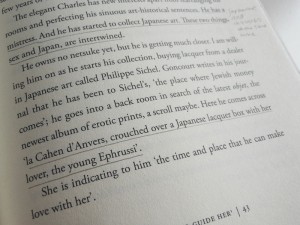An unexpected success in England and still climbing bestseller rungs all over the world, The Hare with the Amber Eyes by Edmund de Waal is an exhibition in book form. The author, a potter, tells the history of his Jewish banking family, the Ephrussis, via the artifacts it collected, cared for, and bequeathed. 
The objects gain meaning via detailed descriptions. Who acquired them, at which time, for what purpose? What do they say about their buyer’s character, heritage, and destiny? Among the artifacts is the title-giving “Hare with Amber Eyes,” one of 264 Japanese netsuke wood and ivory carvings, which changes hands many times. First bought in Paris by Charles Ephrussi (1849–1905, who was the muse for Marcel Proust’s title figure in Swann’s Way) together with his married lover, the objects are secretive, sensual and exotic, and part of a general trending fondness for all things Japanese. Many years after the affair is over, they are presented as a wedding gift to a cousin, Emmy Ephrussi (1860–1945), who keeps them as toy figurines for her children to play with. When her palace is ransacked by Nazi officers, her servant Anna hides them in a mattress. Now, it is their resilience, their small size and modularity, which tells of the times. De Waal shows us to what extent the value, significance and meaning of objects depends on how they are used and described.
The Hare with Amber Eyes is a lesson to museums, which themselves collect, analyse and label historical objects. Their value depends on how we explain them, how we curators view their epoch, and what we want to convey of our own history. And narration is versatile. What we choose to say about our objects today, may be quite different from the stories they tell several years later. (Edmund de Waal, The Hare with the Amber Eyes, New York: Farrar, Straus and Giroux 2010.)
Naomi Lubrich, Media